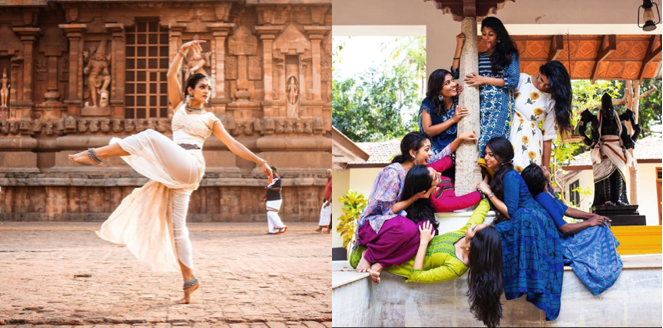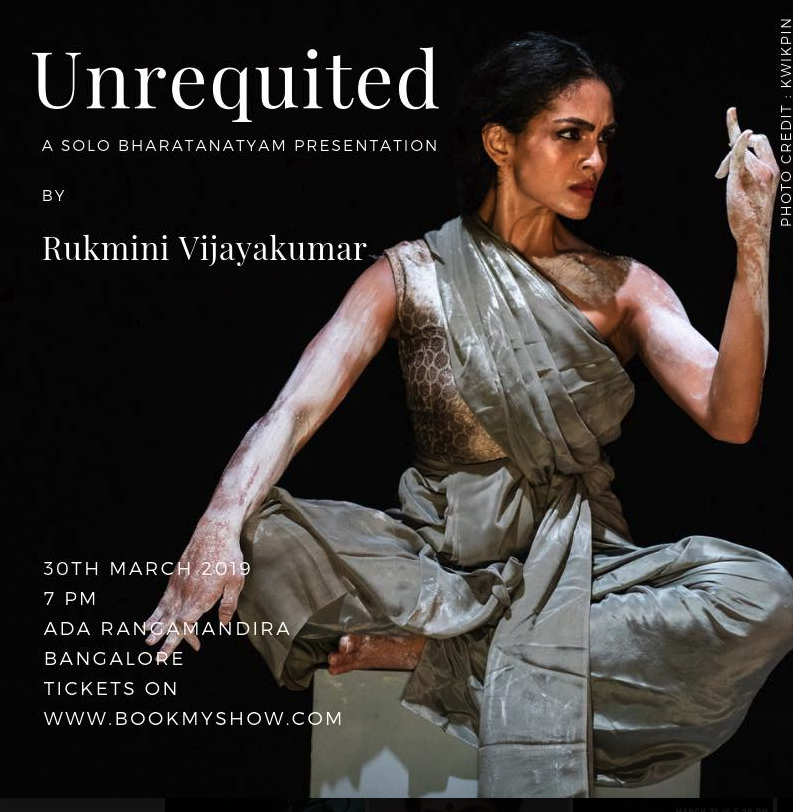What makes the work of dancer Rukmini Vijayakumar so brilliant? This third and final article focuses on gentleness and strength as the qualities that bring heart to her work – and make her an inspiring artist and public figure.
Wings
Strength and gentleness are said to be the two wings of a single bird. As a union they lend great attractiveness and worthiness to the one who possesses them. And that person may well be defined as a leader.

Laying bare her feelings, she says in her article Insatiable Practice: “I have never thought of myself as an exceptional or talented dancer. Hardworking, diligent, dedicated, yes. But talented? I am not so certain.”
Her statements resonate because they seem to express a universal human feeling. Similarly, her website is sprinkled with gems of gratitude that are an object lesson in the spirit of this quality that most life gurus consider essential for good mental health.
I would recommend two blog reads in particular: Support, which recognises the selflessness of people who support an artist’s life; and Homage to my Teachers, which reminds us not to forget the people who built us.
Top of Page
The Bird’s Flight – in Dance
A highly regarded classical dancer on the international circuit, in 2011 the New York Times wrote of her “…burning eyes that repeatedly catch the observer’s breath … she makes those eyes part of the fabric of the dance”.
It went on: “In terms of gesture, switches of angle and communicating swift changes of emotion (alarm, then surprise, then joy), she is not just engaging but also authoritative.”

Vijayakumar performed a solo performance, Abhimata, at The Bhavan in London, UK, this November and I can attest that these qualities were very much in evidence.
The way in which Vijayakumar’s demeanour could change from gentle to fierce was arresting.

Despite being a young, internationally trained dancer (see The Classicism of a Modern Dancer), Vijayakumar’s demeanour is sympathetic to the devotional nature of Indian classical dance.
Her English language explanations at the very start of her solo performance reflected on Divine Love as the essence of the stories traditionally told through Bharatanatyam.
This approach shone through Vijayakumar’s recounting of the moral dilemma faced by Lord Rama, an Indian king and God born in human form whose story is told in the Indian epic, The Ramayana.
Top of Page
Next Section
His queen, Sita, an equally great and noble personage, has been rescued from the clutches of demon king, Ravana. However, as a prisoner in his kingdom, Rama’s citizens believe her now to be impure.
Rama has to decide whether to meet his duties as a king, to keep the peace by rejecting Sita; or to act according to the truth, that Sita is blameless and pure, and accept her back into the kingdom.
In the end, Rama sends Sita to live in a forest hermitage, a decision that has been frequently decried by modern intellectuals, who condemn Rama for anti-feminist behaviour.
Vijayakumar, however, did not choose that route, nor did she choose to find any explanation for Rama’s actions. She chose to portray the pain of the dilemma as it is described in The Ramayana.
According to Vijayakumar, The Ramayana describes Rama as driven almost to madness by the decision with which he is faced.
From High Drama, To Wit
Wit is one of the qualities a Bharatanatyam dancer should possess, according to the ancient guide book on Indian dance, the Natya Shastra.
This quality is not always clearly evidenced in Bharatanatyam performances, but it was apparent in Vijayakumar’s London performance in November.
In particular, a spousal story inspired by her parents and transposed onto a tale about Lord Shiva and his heavenly wife, Parvati, who He seeks to reassure over His relationship with intellectual muse, Ganga.
Humorous throughout, the punchline of the piece was told with a pointedness that evoked particular pleasure from the audience.
Top of Page
… Back to Black
When the final dance of the evening was announced, the audience was told this piece would invoke the blessings of Lord Krishna. It turned out to be a tour de force of lightening fast movements, stretches, leaps and midair poses that were full of charm.
However, it turned out to be the penultimate and not the final dance. Following the prior exuberance the stage was abruptly plunged into darkness. Silence, and then through the gloom the dancer could just be glimpsed sitting at the centre of the stage.

As the darkness gave way to shadows, Vijayakumar’s arms lifted slowly and stiffly, palms joined, above her head. Evoking a deeply mystical invocation, the dancer held a rapt and perhaps slightly nervous audience in her hands.
Top of Page
A Final Act of Modesty
It had been a cold winter evening outside, but the theatre had become warm as it filled to capacity with mostly young Indian women, many of who were dancers, dressed to the nines in glittering saris and velvet gowns.
After the finalé, the evening’s compere entered the stage and invited the audience to ‘meet’ the artist. What unfolded was a far cry from the usual format: a formal Q&A, with the artist sitting on the stage taking questions from the audience.
When the stage door of the auditorium opened after about twenty minutes, Vijayakumar gently meandered out into the aisle, where she was met by a swelling but quiet and respectful crowd.
Her hair loose and tousled, Vijayakumar quietly hugged and greeted her admirers.
Vijayakumar’s quiet, down to earth approach reflected the democratic and humanistic roots of her ancient art. It could only endear her both to those familiar and those new to her work.
Top of Page
This is the third and final part of a series of articles on Rukmini Vijayakumar.



Superb.
One suggestion!.
Instead of using “Vijayakumar”.. Please use Rukmani. Vijayakumar is her father’s name.
Tamil names traditionally include the family’s place of origin, the father’s name, and given names, sometimes punctuated with the caste name (now less common). Often in writing, the place of origin and/or the patronym are initialized. For example, Maruthur Gopala Ramachandran(MGR) has a given name of Ramachandran, his father’s name was Gopala, and his family is from the village of Maruthur. Kannada names and Malayalam names are similar to Tamil names. Telugu names are usually one or more surnames followed by one or more given names. Southern Indians may sometimes write the given names before the surnames, especially on legal documents. So Rukmani is her given name (Like Girija).
Thank you
LikeLike
Hi Veera,
Many thanks for reading and engaging with my content, much appreciated.
I am really sorry if the style has offended you. It is simply the style of formal writing – journalistic and indeed academic. It maintains a professional distance between the publication and the person being written about. For example, if one needs to critique someone, it is too close and rather rude to say, for example: Anne needs to improve her posture if she is to….. Better to say: Smith needs to improve her posture if she is to. I admit that I am often tempted to write the first names of people I write about on my blog to sound less formal. However, it is effectively a line I would have to professionally cross and so I am hesitant. I hope this explains why this style is in place.
All the best,
Girija
LikeLike
I really enjoy reading your throughly analysed articles. FYI, I have forwarded these to Rukmani Vijayakumar. Keep up the good work.
Best Regards
Veera
LikeLike
Thank you Veera, that is very kind of you. It would be fine to get an interview with Rukmini, but I would have to think carefully of where to begin as she is such a multifaceted talent.
Wishing you a great weekend.
Best regards,
Girija
LikeLike